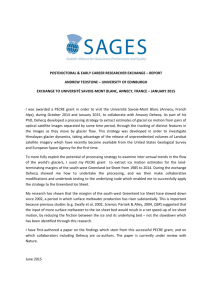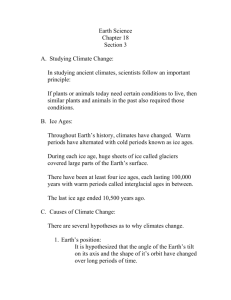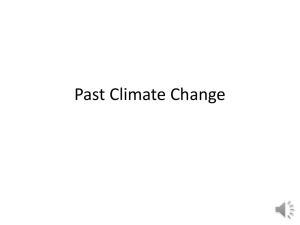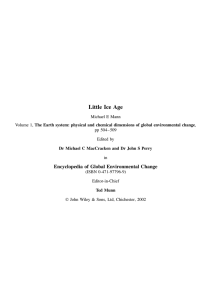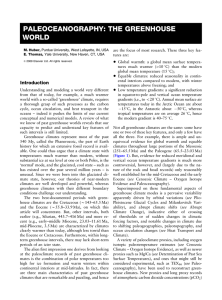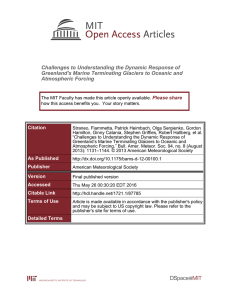climate change slides
advertisement
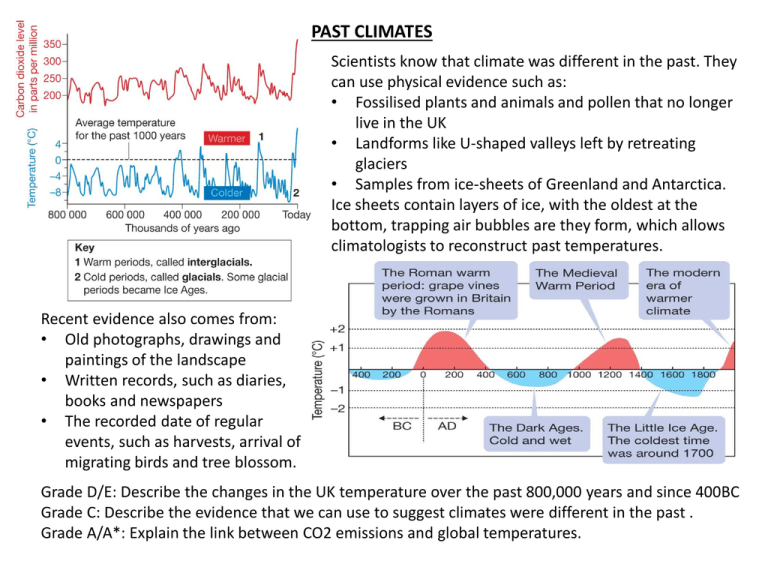
PAST CLIMATES Scientists know that climate was different in the past. They can use physical evidence such as: • Fossilised plants and animals and pollen that no longer live in the UK • Landforms like U-shaped valleys left by retreating glaciers • Samples from ice-sheets of Greenland and Antarctica. Ice sheets contain layers of ice, with the oldest at the bottom, trapping air bubbles are they form, which allows climatologists to reconstruct past temperatures. Recent evidence also comes from: • Old photographs, drawings and paintings of the landscape • Written records, such as diaries, books and newspapers • The recorded date of regular events, such as harvests, arrival of migrating birds and tree blossom. Grade D/E: Describe the changes in the UK temperature over the past 800,000 years and since 400BC Grade C: Describe the evidence that we can use to suggest climates were different in the past . Grade A/A*: Explain the link between CO2 emissions and global temperatures. CAUSES OF CLIMATE CHANGE Grade E: Name the three natural causes of climate change. Grade C: Explain how big volcanic eruptions might change our climate. Grade B: Explain how orbital changes affect our climate. Grade A/A*: Which theory will have greatest impact on our climate? Eruption Theory Big volcanic eruptions can change the Earth’s climate. Volcanic eruptions produce ash and sulphur dioxide gas. They can reach the stratosphere and this blanket of ash will stop some sunlight reaching the Earth’s surface, reflecting sunlight back into space. This cools the planet and lowers the average temperature. Orbital Theory The Earth’s orbit changes over long periods of time, which may explain why there are big changes in the Earth’s average temperatures. The Earth’s orbit is sometimes circular, and sometimes more of an oval shape. The Earth’s axis tilts. Sometimes it is more upright, and sometimes more on its side. The Earth’s axis wobbles, like a spinning top about to fall over. On timescales of thousands of years, the changes in the orbit of the Earth, called Milankovitch cycles could explain the changes in climate. Sunspot Theory Sunspots are black areas on the suface of the sun. Sometimes the sun has lots of these black spots, and at other times they disappear. This dark spots tell us the sun is more active than usual, which means more energy being fired out from the sun to the Earth. IMPACT OF CLIMATE CHANGE Viking Greenland Warmer climates in Greenland meant that by 1100 Greenland had: • Over 200 farms – keeping goats, sheep and cows, and growing hay (grass) to feed the animals • A population of 3000-4000 Vikings • Trade links with Iceland and Norway • Summer hunting expeditions north of the Arctic circle, for seals and Whales. However, by the time the Little Ice Age arrived: • Deforestation and soil erosion meant that the Viking farms probably produced little food as they had damaged the land they depended on. • The trade route between Iceland and Norway stopped because of sea ice • The Greenland Vikings were not very adaptable. • They became very isolated in a damaged environment with no way to change their lifestyle. Little Ice Age During the Medieval warm period (900-1350AD) new land was given over to farming. However, when the Little Ice Age took hold (1315AD): • Cold and rain lashed Europe in the spring and summer of 1315 • Wheat and oats did not ripen and the harvest failed • The cool wet weather continued into 1316 and 1317 • By 1317 the ‘Great Famine’ had begun, and it lasted until 1325 • In some areas 10-20% of the peasant farmers may have died from hunger. The arrival of the Black Death in 1349 was probably made worse by a colder climate and more challenging farming conditions. In the Alps glaciers advanced down the valleys, destroying villages and farmland. Many farmers stopped growing wheat as it became difficult to farm, and instead grew potatoes from South America, which liked the wet and cold. Grade E: Impact on Wildlife: When climates have changed, it has spelled disaster for some plants and animals. Megafauna are big animals that weigh more than 40kg. As the climate warmed after the last Ice Age many animals migrated as they tried to find new areas to live in where the climate suited them. Finding the right plants to eat would have been difficult and a warmer climate would have disrupted food chains, leaving some animals short of food. Climate stress may also have made megafauna weaker than normal. What impact did a warmer climate mean for the Vikings? Grade D/C: Explain the impact of the Little Ice Age on the UK. Grade A/A*: What impact did the end of the Little Ice Age have on wildlife? CLIMATE CHANGE % of greenhouse gases produced Sources 89% Burning fossil fuels (coal, oil and gas), deforestation which releases CO2. Methane 7% Gas pipeline leaks, farming rice in paddy fields, cattle farming. Nitrous oxide 3% Jet aircraft engines, cars and lorries, fertilizers and sewage farms 1% Used in industry, solvents and cooling equipment Greenhouse Gas Carbon Dioxide Halocarbons Grade E: What are the four main greenhouses gases? Grade D: Make a list of human actions that add to greenhouse gases. Grade C: Explain what the enhanced greenhouse effect is. Grade A/A*: Explain why people in the developing world produce only small amounts of greenhouse gases. CLIMATE FUTURES Climate change has been evidenced because: • Global temperatures have risen by 0.75C between 1905 and 2005. • Sea levels have risen by 195mm from 1870 to 2005 – due to thermal expansion. • 19 of the 20 warmest years have been since 1980 • Floating sea ice in the Arctic shrank from 7.6m km2 in 1980 to 4.4m km2 in 2007 • Over 90% of the world’s valley glaciers are shrinking Scientists estimate that temperatures will rise between 1.1C and 6.4C by 2100 and that sea levels could rise by between 30cm and 1 metre by 2100. Possible impacts on the UK are: • Low-lying coasts like East Anglia and Essex could flood • Some coastlines could erode more rapidly so coastal defences could cost more • Heatwaves, just like in summer of 2003 • Flooding, just like summer 2007 & January 2014 • Storms, like 1987 and in1990 • Greater insurance claims • More money spent on infrastructure resilience to lessen the impact of flooding • Water shortages could become more common • There could be more illnesses such as heatstroke and skin cancer • Farmers might have to change crops to those than need less water and more sunshine • Some plants and animals might die out if the UK gets too hot • More people could holiday in the UL • New crops might mean new sales opportunities • More land could be farmed at higher latitudes Predicting the future climate is going to be very difficult because we don’t know: • What the world’s future population will be; • If we will continue to use fossil fuels or use cleaner renewable energy • If people will change their lifestyles, e.g. recycle more All countries need to work together to reduce the impact of climate change: • We could reduce our consumption of fossil fuels and switch to ‘green energy’ • We could recycle more • We need to use cars less and public transport more • We need tor reduce our ecological footprint Grade E: Identify two pieces of evidence that suggests UK’s climate is changing. Grade D:Why is it hard to predict how temperatures might change in the future with global warming Grade C:How might the UK be affected by climate change Grade B: How might international co-operation help reduce the impact of climate change? Grade A/A*: Describe how global warming might bring costs and benefits to the UK.


